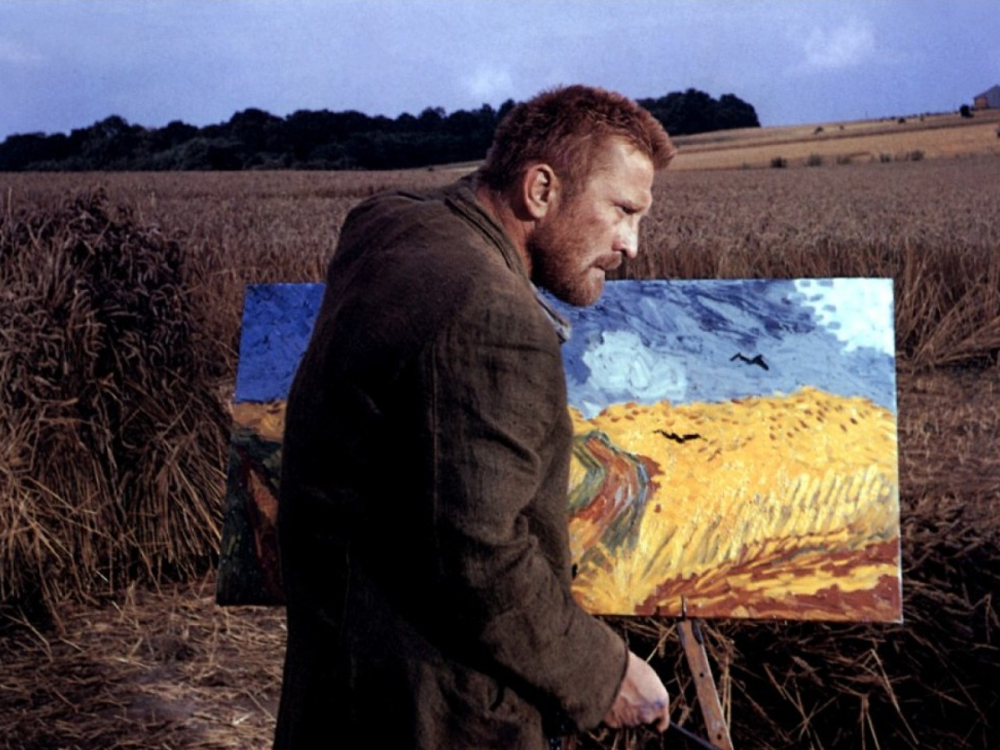
The life of brilliant but tortured artist Vincent van Gogh.
Paul Gauguin: With all your talk of emotion, all I see when I look at your work is just that you paint too fast!
Vincent van Gogh: You look too fast!
“If ever a picture shouldn’t have been filmed in Cinemascope, it was Lust for Life, since the dimensions of the wider screen bear little relation to the conventional shape of paintings. Arthur Loew, a studio executive, insisted otherwise. John and I tried to dissuade him, but to no avail.
“Wouldn’t you rather be responsible for the composition, instead of trusting it to a projectionist in a theater?” he asked.
“What do you mean?” John asked.
“No matter how you shoot it, it’s going to be projected in Cinemascope, and millions of people are going to see it in Cinemascope. You can shoot it any way you want, but just remember that fact.”
It was an unanswerable argument. Cinemascope it would have to be.
There was one fight we fortunately won. I’d noticed that Eastman negatives, in which Metro’s color pictures were then being shot, didn’t have the subdued tones that would be needed in a film about Van Gogh The color process had originally been developed for Twentieth Century-Fox’s production of The Robe in 1953, and the palette was straight from the candy box, a brilliant mixture of blues, reds, and yellows that resem bled neither life nor art. Since that time, Cinemascope and Eastman color had become as inseparable a team as, say, Dean Martin and Jerry Lewis. But events had proved how constant that association was, and perhaps there was hope for us too.”
Vincente Minnelli1
“As we might expect, the French in the fifties and sixties debated about whether Minnelli was an auteur or simply a metteur-en-scène; in fact, a controversy over this issue, centering chiefly on Lust for Life, provoked André Bazin into writing a famous rebuke of his younger colleagues, where he pointed to the “genius of the system.” Even the most devoted of the auteurists were divided over Minnelli. For some, he was a sly satirist of the ‘American way of life’; for others, he was a talented hack.”
James Naremore2
“Van Gogh’s five volumes of letters to his brother Theo were of enor mous help. I pored over them, marking anything of significance, developing an attitude I felt the picture should convey. The sun subconsciously represented turmoil to Van Gogh, the mael strom he was always fighting, for it was a symbol used in many of his paintings. Streaks and whorls around the sun and lamps represented the inner core, his inherited insanity. Never did a color palette so closely parallel an artist’s life. Van Gogh was to paint for only eight of his thirty-seven tortured years. His first drawings in the Borinage, where he worked in the mines, are all in black, as if they were covered in coal dust. They reflect his somber mood at the time. Then he became ill, and went home to Holland, where his paintings are dominated by the dark green of the countryside, as seen in paintings of his Dutch contemporaries. Later in Paris, dazzled by the Impressionist school, his colors are splashed in brilliant reds and blues. Painters like Gauguin, already es tablished, considered Van Gogh just an amateur, the brother of a very successful art dealer. Van Gogh shows his admiration for them by emulat ing them within the limits of his own vision.”
Vincente Minnelli3
“Zoals we kunnen verwachten, discussieerden de Fransen in de jaren vijftig en zestig over de vraag of Minnelli een auteur was of enkel een metteur-en-scène; een controverse over deze kwestie, hoofdzakelijk gericht op Lust for Life, bracht André Bazin er zelfs toe om een beroemde berisping aan het adres van zijn jongere collega’s te schrijven, waarin hij wees op het “genie van het systeem”. Zelfs de meest toegewijde aanhangers van de auteurstheorie waren verdeeld over Minnelli. Voor sommigen was hij een geslepen satiricus van de ‘American way of life’; voor anderen was hij een getalenteerde loonslaaf.”
James Naremore4
- 1Vincente Minnelli, I Remember it Wel (New York: Doubleday & Company, Inc., 1974).
- 2James Naremore, “Minnelli, the Aesthete in the Factory,” Sabzian, 26 July 2017.
- 3Vincente Minnelli, I Remember it Well (New York: Doubleday & Company, Inc., 1974).
- 4James Naremore, “Minnelli, de estheet in de fabriek,” Sabzian, 26 juli 2017.

